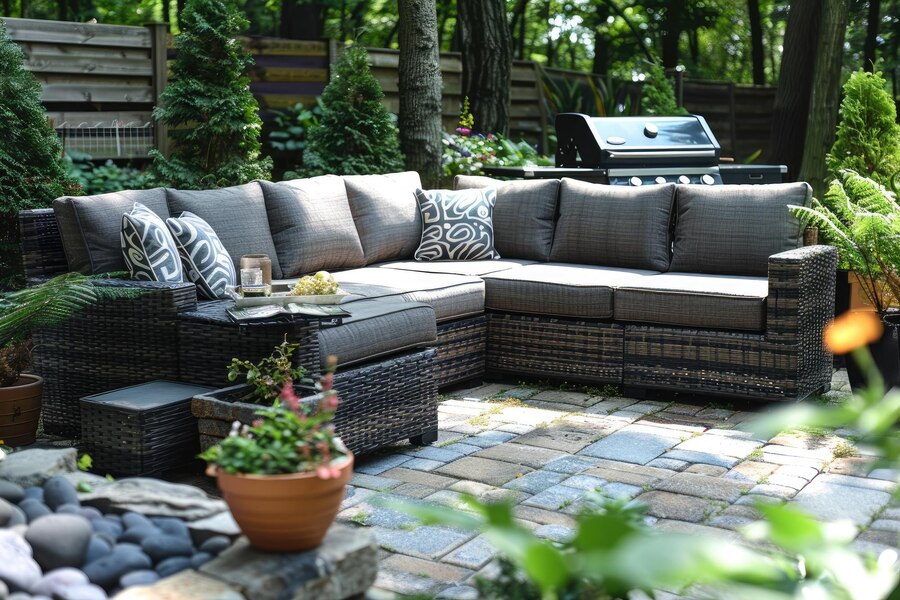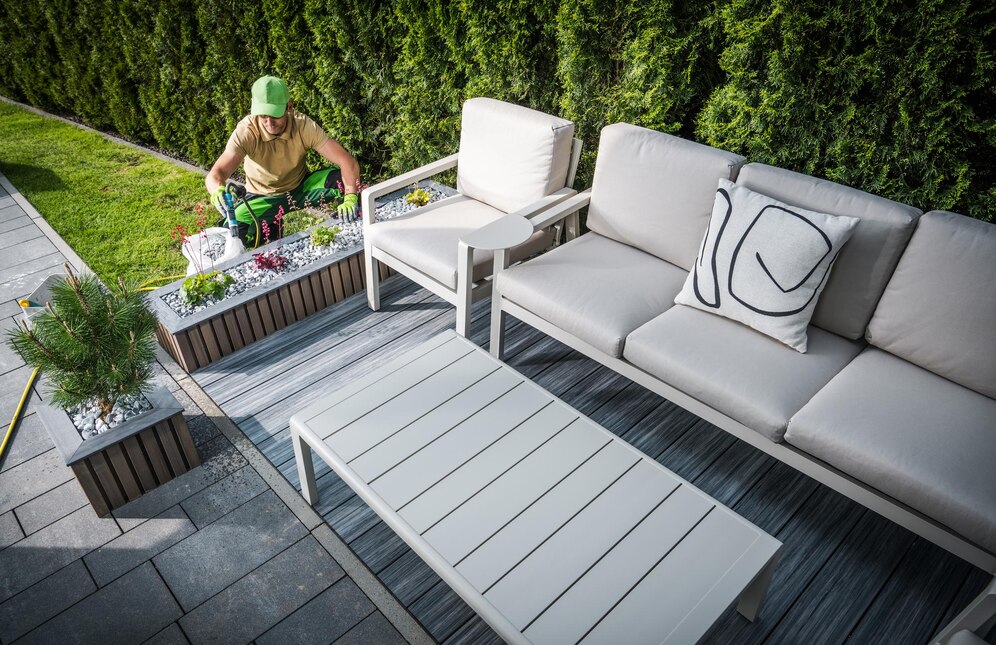Best Patio Material: Comprehensive Guide (with Photos)
12 April, 2024
A patio, a key garden element, enhances the outdoor experience when designed with suitable materials. In this article, we will analyze various options and try to find out what is the best material for a patio.
10 Most Popular Types of Patio Materials
Patio floors offer a wide variety of styles and materials—natural, artificial, solid, pour-in, loose-fill, dyed, or in native colors. Let’s delve into variants and find the best patio paving materials.

Natural Stone
Natural stone is an exceptional decoration for almost any garden and one of the most aesthetically appealing and durable materials. Even nowadays, it’s arguably the best material for patio floor due to these pros:
- Durability – stone is practically invulnerable to wear and weathering, which can last centuries.
- Aesthetics – although stone’s design options are not as diverse, stone offers a unique image suitable for any outdoor style. Moreover, numerous types of stone, like granite, slate, or limestone, enable you to create your unique style.
However, stone patio owners need to be aware of such caveats:
- Moisture – stone tends to become highly slippery when wet, which can lead to serious injury after a fall, considering how hard the stone is.
- Price – stone is a relatively expensive material, costing $16 to $35 per square foot on average, depending on the total area and type of stone you go for.
Porcelain Pavers
Although they are often confused with stone tiles, porcelain pavers are another popular choice regarding patio flooring. Here are some of the reasons porcelain pavers can be the best material for outdoor patio:
- Low-maintenance – porcelain pavers are a pretty low-maintenance and durable material, resistant to stains, scratches, or fading.
- Design – porcelain pavers fit modern and sleek designs, complementing them excellently.
Despite that, it is crucial to remember that all of these pros also come with a few unpleasant cons:
- Professional installation – porcelain pavers are unsuitable for DIY installation, resulting in high professional installation costs.
- Price – based on the type of clay you decide to go for, you will need to pay from $10 per square foot for plain-looking tiles to $30 per square foot for the ones that mimic wood or stone.
Rubber
Due to its properties, rubber has become one of the most widely used synthetic materials, providing excellent service and fortitude. Here are some of the most crucial pros of a rubber floor covering:
- Comfort – rubber provides excellent shock absorption, meaning walking, running, jumping, or even falling on it won’t lead to serious injury, joint damage, or any other discomfort. Moreover, rubber remains a non-slip surface even when it’s wet.
- Eco-friendliness – most rubber is produced from natural materials, which are virtually zero-waste or recycled older rubber, making it a sustainable and environmentally friendly material.
Unfortunately, there is no such thing as a perfect material, meaning that even rubber has certain cons:
- Appearance – although rubber is highly versatile and can come in numerous colors and patterns, its texture and feel might only fit into some outdoor design choices.
- Price – depending on the type of rubber that you decide to install on your patio, you will need to pay $6 to $20 per square foot.

Gravel
Gravel is one of the most common loose-fill materials for almost any space. Many homeowners decide to opt for gravel due to the following reasons:
- Cost – pea gravel is a relatively cost-efficient material, costing about $1 to $3 per square foot, almost twice as cheap as many other surfacing options.
- Drainage – due to it being loose-fill, gravel provides excellent drainage, preventing water accumulation on walking surfaces.
- Visuals – like any other natural material, gravel fits perfectly into almost any design, offering a down-to-earth and cozy feel.
Let’s also take a look at some drawbacks of owning a gravel-flooring patio:
- Uneven surface – gravel cannot provide a stable, steady surface for furniture with legs. Subsequently, it is almost impossible to have chairs, tables, and other pieces of furniture on such a patio.
Cobbles and Pebble Mosaic
Cobbles and pebble mosaics perfectly show how solid and loose-fill materials combine, making gorgeous, sturdy flooring. Here are some of the main pros of installing it:
- Aesthetics – mosaics made of cobbles or pebbles are highly customizable, enabling you to install them in almost any pattern.
- Durability – if the mosaic is installed correctly, it can withstand almost any conditions without forming cracks or potholes under any weather, moisture, or impact.
Don’t forget that all of these pros also come with quite unpleasant cons:
- Installation – unlike many other options, mosaics can’t be installed single-handedly, requiring a professional team to do everything correctly. Moreover, installing it in an intricate pattern can be pretty tricky.
- Comfort – many people find cobblestones and pebbles uncomfortable to walk barefoot, and like any other stone, they are pretty solid, meaning they can lead to an injury after the fall.
Bark Mulch
Another loose-fill material that has been applied to patio flooring is bark mulch. Ecologically clean and beautiful, it is an excellent complement to any naturally-looking gardens, yards, and patios for the following reasons:
- Aesthetics – just like any other organic materials, bark mulch is an excellent choice if you want to go with the natural feel of your patio.
- Erosion control – bark mulch helps prevent soil erosion, meaning that if placed near trees, flowers, and other plants, it helps them grow better and be healthier overall.
- Eco-friendliness – bark mulch is renewable and biodegradable, which doesn’t lead to contamination.
Still, mulch can be a rather demanding surface for the following reasons.
- Weed growth – as an organic material, bark mulch is susceptible to growing weeds and other unwanted vegetation.
- Maintenance – just like other loose-fill materials, like gravel, dirt, or sand, bark mulch is highly demanding in maintenance, requiring frequent cleaning, raking, and refilling.
Wood
Wood has been the most widespread building material for centuries, nowadays also finding its application in gazebos, various types of floorings, or patios. Besides being an incredibly nostalgic option, it also has a few other benefits:
- Versatility – wood can come in various colors and textures, dyed or painted. You can even go for different kinds of wood, each with unique features. Moreover, wood is an excellent material for all the other parts of your patio – walls, pillars, furniture, roof, etc.
- Aesthetics – many would agree that nothing can compare with the looks of a wooden surface. Nostalgic yet natural, wood fits perfectly into practically any design style.
- DIY-friendliness – compared to other materials, especially synthetic ones, wood is relatively easy to install singlehandedly, requiring just a few tools.
However, it’s crucial to be aware of a few reasons why wood might not be the best material for patio floor:
- Durability – wood is susceptible to harsh weather conditions and rapid temperature changes, causing it to fade, rot, or crack. Moreover, wood can be easily damaged by insects or heavy impact. Additionally, remember that wood is highly flammable, so installing a fire pit, a grill, or a fireplace in it is a terrible idea.
Bricks
To many’s surprise, brick can be not only the building material for your living space but also an excellent patio flooring for the following reasons:
- Classic appearance – just like wood or stone, brick has its classic and timeless look, making it a desired option for any outdoor space. Moreover, installing them in various patterns is possible, adding intricacy to your outdoor design.
- Durability – bricks are exceptionally durable and invulnerable to most weather conditions, high foot traffic, extreme temperatures, or moisture.
- Installation – bricks can be installed individually without professional help. However, the installation may get tricky if you install them in an intricate pattern.
Moreover, brick flooring is bound to come with the following issues:
- Weed growth – joints between the bricks can be a nurturing space for unwanted weeds, which must be cleaned regularly.
- Safety – bricks are pretty solid, meaning that things that fall on them are sure to break, not to mention injuries on fall.
Concrete
Sidewalks, walking tracks, pool decks, patios – all benefit from a concrete floor. Highly durable and long-lasting, it can make for a fantastic flooring option. Here are a few more pros of concrete patio flooring:
- Affordability – concrete is a relatively cost-efficient material, considering that its price averages at approximately $15 per square foot (however, it depends on the kind of concrete and installation you choose)
- Aesthetics – concrete is versatile and can mimic other materials, like pavers, stone, wood, etc. Moreover, you can go for interlocking concrete pavers, which can be installed in countless patterns.
- Low maintenance – after the initial hardening, concrete requires little to no maintenance.
Still, many concrete flooring owners face with the following issues:
- Cracking – concrete can develop cracks over time due to stressor factors like harsh weather, substantial impacts, and extensive use.
- Heat retention – concrete tends to become quite hot in direct sunlight, making it almost impossible to walk barefoot.
Terracotta
Terracotta, or red clay tiles, is a classy choice for countless patios. Here are some of the reasons so many patios can be found covered in terracotta:
- Durability – terracotta tiles resist most wear and tear, keeping their form even in the harshest conditions.
- Heat resistance – terracotta doesn’t become hot in sunny weather, remaining chilly and pleasant to walk on.
- Aesthetics – clay tiles offer a unique Mediterranean charm wherever they are installed. Moreover, they can come in various irregular shapes and form intricate patterns.
Still, before opting for terracotta, consider the following:
- Sealing – terracotta tends to stain and fade with time, so you must seal it.
Maintenance and Care
Now, let’s discuss a crucial point you will face after installing your patio – how to take care of it. Generally, the maintenance requirements of your flooring depend on your chosen material.
Some materials, like porcelain, rubber, concrete, or natural stone, are low-maintenance, easy to clean, and do not require much extra work due to their durability. On the other hand, loose-fill materials like gravel and bark mulch or others, like terracotta or bricks, require much more work around them to ensure they don’t grow with weeds or age too quickly. Moreover, more complex materials, like cobbles and pebble mosaics, are highly demanding in how they are installed, offering excellent durability if installed correctly or losing most of their properties after an improper installation.
In addition to that, don’t forget that maintenance comes not only with work but also with extra spending on consumables, tools, extra materials, or even professional help. Therefore, consider maintenance expenses when calculating the budget for your patio.
Making Your Decision
Although the cost and difficulty of maintenance play a crucial role in choosing the flooring option for your patio, it is not the only one. Here are a few factors to consider to choose the best patio material for you:
- Budget – determine the budget that you would be comfortable with. Don’t forget that it should include the material, installation, and maintenance costs.
- Climate – some materials, like terracotta, perform well in hot climates; some, like concrete or wood, suffer from rapid temperature change, and some, like rubber, are weather-resistant. Consider the climate you’re living in to choose the material that would perform best.
- Aesthetics – look at your overall exterior design and consider what material will fit it better. Generally, natural materials like wood, stone, or porcelain fit anywhere but feel free to express yourself.
